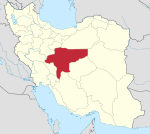New Julfa
New Julfa
Նոր Ջուղա | |
|---|---|
 Courtyard of the Holy Savior Cathedral, and the Museum of Khachatur Kesaratsi | |
| Coordinates: 32°38′10.79″N 51°39′20.55″E / 32.6363306°N 51.6557083°ECoordinates: 32°38′10.79″N 51°39′20.55″E / 32.6363306°N 51.6557083°E | |
| Country | Iran |
| Province | Isfahan Province |
| Counties | Isfahan County |
| City | Isfahan |
| Settled | early 17th century |
New Julfa (Persian: نو جلفا – Now Jolfā, جلفای نو – Jolfâ-ye Now; Armenian: Նոր Ջուղա – Nor Jugha) is the Armenian quarter of Isfahan, Iran, located along the south bank of the Zayande River.
Established and named after the older city of Julfa (Jugha), Nakhichavan in the early 17th century, it is still one of the oldest and largest Armenian quarters in the world.
History[]


New Julfa was established in 1606 as an Armenian quarter by the edict of Shah Abbas I from the Safavid dynasty. Over 150,000 Armenians there from Old Julfa (also known as Jugha or Juła) in Nakhichavan. Iranian sources state that the Armenians came to Iran fleeing the Ottoman Empire's persecution. Nevertheless, historical records indicate that the residents of Julfa were treated well by Shah Abbas in the hopes that their resettlement in Isfahan would be beneficial to Iran due to their knowledge of the silk trade.[1][2]
Since its foundation, New Julfa was administered by the Lazaryan noble family which moved to Russia after Nader Shah's death in 1747.[3] One of its members, Ivan Lazarev, became a court banker to Catherine the Great and was made an Imperial Count in 1788. His brother established the Lazarev Institute in Moscow.
In 1947, the historian Fernand Braudel wrote that the Armenians had a trade network that stretched from Amsterdam to Manila in the Philippines. Many scholars in Armenia have done pioneering work on this network in the 60s, 70s and 80s. Levon Khachikian and Sushanik Khachikian have edited and published several New Julfan account books. Over the next few centuries, New Julfa became the hub of "one of the greatest trade networks of the early modern era,"[4] with outposts as far east as Canton, Surabaya, and Manila,[5] and as far west as Cadiz, London, and Amsterdam, with a few merchants traveling across the Atlantic or Pacific oceans to Acapulco or Mexico City.

A significant majority of Armenian trading families were based in New Julfa. Due to their dispersal, many families that were originally from the older city of Julfa[2][1][6] created a main settlement in Bengal expanding the trade network based in New Julfa.[1] However, Some scholars argue that Surat, Bengal and Hughli were independent nodes and that the central control of New Julfa was not as important to their thriving Indian Ocean trade.[5] Many New Julfan Armenians later settled in Manila, Hong Kong, and also in Australia. Their networks have been studied based on Armenian sources.[1][2] Some also settled in Singapore, where Armenians from New Julfa became the mainstay of the Armenian community in the country. Most were traders, but perhaps better known were the Sarkies (Ter Woskanian) brothers who founded Singapore's Raffles Hotel in 1887.
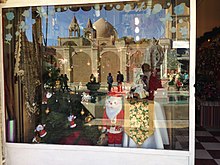
New Julfa is still an Armenian-populated area with an Armenian school and sixteen churches, including the Holy Savior Cathedral. Armenians in New Julfa observe Iranian law with regard to clothing, but retain a distinct Armenian language, identity, cuisine, and culture which is protected by the Iranian government.[7]
According to David Petrosyan of the Institute for Central Asian and Caucasian Studies, New Julfa had between 10,000–12,000 Armenian inhabitants in 1998.[8] As of today, it is still one of the world's largest ethnic Armenian quarters. The district is popular with young people in Isfahan, and is experiencing considerable growth compared to other districts of the city.
Sites[]
Churches[]

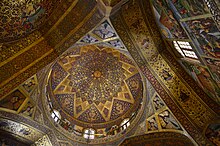
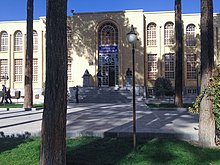
Armenian Apostolic[]
- Holy Savior Cathedral (Surp Amenaprgich, commonly known as the Vank) – 1655
- Saint Jacob Church (Surp Hakop Mdzbena Hayrapet) – 1607
- Saint George Church (Surp Gevork) – 1611
- Holy Mother of God Church (Surp Asdvadzadzin) – 1613
- Saint Stephen Church (Surp Stepanos Nakhavga) – 1614
- Saint John the Baptist Church (Surp Hovannes Mgrditch) – 1621
- Saint Catherine Convent (Surp Katarine) – 1623
- Holy Bethlehem Church (Surp Betłehem) – 1628
- Saint Nicholas Church (Surp Nikołayos Hayrapet) – 1630
- Saint Gregory the Illuminator Church (Surp Grigor Lusavoritch) – 1633
- Saint Sarkis Church (Surp Sarkis) – 1659
- Saint Minas Church (Surp Minas) – 1659
- Saint Nerses Church (Surp Nerses Medz) – 1666
Roman Catholic[]
- Cathedral of Our Lady of the Rosary (Dominicans) – 1681/1705
Protestant[]
- Saint Paul Church – 1875
- Seventh-day Adventist – 1957
- Assemblies of God – 1965
Museums[]
- The museum of Khachatur Kesaratsi, in the compound of the Holy Savior Cathedral
Schools[]
- Samian (1831–1853) (hy)
- Katarinyan (1858–now) (hy)
- Azgayin Kntronakan (1880–now) (hy)
- Gevorg Kananyan (1905–now) (hy)
Notable people[]

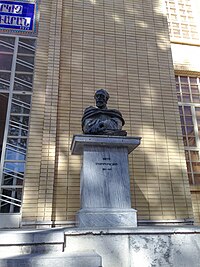
- Apcar family – merchant family
- Sceriman family – merchant family
- De l'Estoile family – merchant family
- Lazarian family (ru) – noble family
- Sarkies Brothers – businessmen
- Khvajeh Safar (d. 1618) – mayor of Julfa
- Martin the Armenian (hy) (d. 1619) – first Armenian-American / Iranian-American
- Khachatur Kesaratsi (1590–1646) – archbishop and publisher
- Khvajeh Petros Velijanian (fa) (d. 1649) – merchant
- Mesrop of Khizan (c.1560–c.1652) – manuscript illuminator
- Simeon Jughayetsi (ru) (d. 1657) – scholar
- Mirman Mirimanidze (17th century) – mayor of New Julfa
- Otar Beg (1583–1663) – mayor of New Julfa
- Hakop Jughayetsi (ru) (17th century) – manuscript illuminator
- Siet Khachikian (hy) (17th century) – diplomat
- Hovhannes Jughayetsi Ktreshents (hy) (c.1610–c.1660) – publisher
- Mohammad Beg (d. 1671) – mayor of New Julfa
- Voskan Yerevantsi (1614–1674) – publisher
- Hajji Piri (d. 1694) – mayor of New Julfa
- Bogdan Saltanov (1630–1703) – painter
- Hovhannes Mrkouz (hy) (1643–1715) – philosopher
- Egaz Norjughayetsi (hy) (1650–1734) – musician
- Stepanos Dashtetsi (ru) (1653–1720) – writer
- Abgar Ali Akbar Armani (d. 1708) – merchant
- Alexander I of Julfa (d. 1714) – Catholicos (1706–14)
- Petros di Sargis Gilanents (ru) (d. 1724) – merchant
- Hagopdjan de Deritchan (d. 1726) – diplomat
- Coja Petrus Uscan (1680–1751) – merchant
- Aghazar Lazarian (hy) (1700–1782) – merchant
- Marcara Avanchintz (17th century) – merchant
- Tovmas Khojamalian (hy) (c.1720–1780) – historian
- Shahamir Shahamirian (1723–1798) – political activist
- Ivan Lazarevich Lazarev (1735–1801) – jeweller
- Petros Kalantarian (hy) (1735–1???) – physician
- Minas Lazarian (hy) (1737–1809) – politician
- Astvadsatour Babikian (hy) (1738–1825) – writer
- Khachatour Lazarian (hy) (1741–1774) – politician
- Hovakim Lazarian (hy) (1743–1826) – political activist
- Movses Baghramian (18th century) – political activist
- Tadevos Soginian (hy) (18th century) – political activist
- George Manook (1763–1827) – merchant
- Hakob Hovnatanyan (1806–1871) – painter
- Tadevos Avetoumian (hy) (1811–1863) – writer
- Zerouni Masehian (fa) (1811–18??) – goldsmith
- Megrtich Emin (ru) (1815–1890) – scholar
- Minus Megerdich Zorab (1833–1896) – painter
- Mirza Malkam Khan (1834–1908) – politician
- Martiros Khan Davidkhanian (fa) (1843–1905) – military officer
- Vittoria Aganoor (1855–1910) – poet
- Minas Manook Basil (Barseghian) (hy) (1857–1922) – physician
- Diana Abgar (1859–1937) – diplomat
- Matevos Aghakhan Karakhanian (fa) (1860–1946) – photographer
- Arathoon Stephen (1861–1927) – businessman
- Hovsep Mirzayan (hy) (1868–1935) – politician
- Mesrovb Jacob Seth (1871–1939) – scholar
- Hovhannes Abkarian (fa) (1875–1931) – musician
- Tigran Abgarian (hy) (1877–1950) – philologist
- Petros Abkar (fa) (1884–19??) – politician
- Megrdich Abgar (hy) (1884–1967) – archbishop
- Minas Patkerhanian (hy) (1885–1972) – photographer
- Markar Galstiants (fa) (1888–1985) – architect
- Guregh Israelian (1894–1949) – Armenian Patriarch of Jerusalem (1944–49)
- Zabel Stepanian-Bartev (fa) (1894–1982) – telegraph technician
- Karo Minassian (hy) (1897–1973) – physician
- Megerdich Khan (fa) (1902–1983) – military officer
- Haykush Ter-Martirosian (hy) (1905–1987) – actress
- Bersabe Hovsepian (hy) (1906–1999) – public figure
- Rafael Atayan (hy) (1907–1990) – writer
- Poghos Petrosian (hy) (1907–19??) – bishop
- Abraham Gurgenian (hy) (1908–1991) – painter
- Annik Shefrazian (1909–1996) – actress
- Aramais Aghamalian (1910–1985) – film director
- Johny Baghdasarian (fa) (1913–1979) – film director
- Sumbat Der Kiureghian (1913–1999) – painter
- Yervand Nahapetian (fa) (1913–2006) – painter
- Emma Abrahamian (fa) (b. 1919) – sculptor
- Alain John (1920–1943) – sculptor
- Alenush Terian (1920–2011) – astronomer and physicist
- Levon Minassian (fa) (1920–2013) – scholar
- Sevak Saginian (fa) (1921–2003) – politician
- Clara Abkar (hy) (1922–1996) – painter
- Hrand Ghoukasian (fa) (1927–1996) – physician and translator
- Arsham Yesayi (fa) (b. 1931) – tennis player
- Neshan Sarkissian (Karekin I) (1932–1999) – Prelate of the Diocese of New Julfa (1971–75), Catholicos of Cilicia (1983–94) and Catholicos of All Armenians (1994–99)
- Nechan Karakéhéyan (b. 1932) – Catholic bishop of New Julfa (2000–05)
- Krzysztof Penderecki (b. 1933) – "Poland's greatest living composer"
- Nikol Faridani (1935–2008) – photographer
- Grish Davtian (hy) (b. 1935) – poet
- Alek Ter-Khachatourian (fa) (b. 1935) – translator
- Varouj Karapetian (fa) (b. 1938) – film technician
- Arbi Hovhannisian (hy) (b. 1942) – film director
- Sako Ghoukasian (fa) (1943–2015) – opera singer
- George Bournoutian (b. 1943) – scholar
- Megerdich Toumanian (hy) (b. 1943) – mathematician
- Vartan Vartanian (fa) (b. 1943) – politician
- Nelson Shirvanian (hy) (1944–2018) – sculptor
- Tigran Toumanian (fa) (b. 1946) – film technician
- Herach Khachatourian (fa) (b. 1948) – politician
- Caro Lucas (1949–2010) – scholar
- Zaven Ghoukasian (fa) (1950–2015) – film director
- Masis Hambarsounian (b. 1950) – boxer
- Georgik Abrahamian (fa) (b. 1952) – politician
- Artavazd Baghoumian (fa) (b. 1953) – politician
- Jirayr Kocharian (hy) (b. 1955) – cartographer
- Hrant Markarian (b. 1958) – politician and chairman of the Armenian Revolutionary Federation
- Robert Beglarian (b. 1961) – politician
- Vahik Trossian (fa) (b. 1967) – football player
- Nairy Baghramian (b. 1971) – visual artist
- Aren Davoudi (b. 1986) – basketball player
- Oshin Sahakian (b. 1986) – basketball player
- Kajayr Hakopian (hy) (b. 1989) – actor
- (b. 1990) – football player
Friendly cities[]
New Julfa has friendly relations with:[9]
 Issy-les-Moulineaux, France
Issy-les-Moulineaux, France
Gallery[]
Entrance of the Vank Cathedral.

Inside the Vank Cathedral.
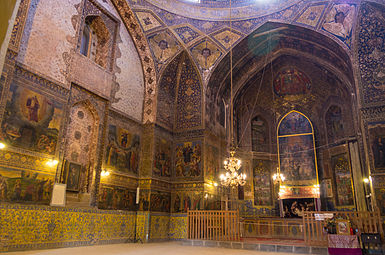
Inside the Surp Bethłehem Church.

Vank Cathedral.

Surp Nikołayos Hayrapet Church.
See also[]
- Armenians in Iran
- List of Armenian ethnic enclaves
References[]
- ^ Jump up to: a b c d Sushil Chaudhuri and Kéram Kévonian eds., Les Arméniens dans le commerce asiatique au début de l’ere moderne [Armenians in Asian trade in the Early Modern Era], (Paris, 2007).
- ^ Jump up to: a b c Baghdiantz McCabe, Ina The Shah’s Silk for Europe’s Silver: The Eurasian Silk trade of the Julfan Armenians in Safavid Iran and India (1590–1750). University of Pennsylvania Series, Scholar’s Press, 1999.
- ^ "ЛАЗАРЕВЫ • Большая российская энциклопедия - электронная версия".
- ^ Sebouh Aslanian. "The Salt in a Merchant's Letter": The Culture of Julfan Correspondence in the Indian Ocean and the Mediterranean. Journal of World History 19 (2008): 127-188
- ^ Jump up to: a b Bhattacharya, Bhaswatti “Making Money at the Blessed Place of Manilla: Armenians in the Madras- Manila Trade in the Eighteenth Century.” Journal of Global History, (2008),3, 1-20.
- ^ Mesrob Jacob Seth, an Armenian historian
- ^ Vasgen Ghougassian The Emergence of the Diocese of New Julfa in the Seventeenth Century, Atlanta, University of Pennsylvania Series), 1998.
- ^ Petrosyan, David (1998). Армянская община в Иране (in Russian). Institute for Central Asian and Caucasian Studies.
...еще 10-12 тысяч - в Исфагане (армяне называют его Новой Джугой)...
- ^ "Ispahan/Quartier de la Nouvelle-Jolfâ (Iran)". Retrieved 17 February 2021.
Sources[]
- Yves Bomati and Houchang Nahavandi,Shah Abbas, Emperor of Persia,1587-1629, 2017, ed. Ketab Corporation, Los Angeles, ISBN 978-1595845672, English translation by Azizeh Azodi.
- Gregorian, Vartan. “Minorities of Isphahan: The Armenian Community of Isphahan, 1587-1722.” Iranian Studies 7, no. 2 (1974), pp. 652–81.
- Aslanian, Sebouh (2011). From the Indian Ocean to the Mediterranean: The Global Trade Networks of Armenian Merchants from New Julfa. California: University of California Press. pp. 1–392. ISBN 978-0520947573.
See also[]
| Wikimedia Commons has media related to New Julfa. |
- Iranian Armenians
- List of Armenian ethnic enclaves
- New Julfa Armenian Cemetery
- Armenian Cemetery in Old Julfa
- Armenian Apostolic Diocese of Isfahan and Southern Iran
- Roman Catholic Archdiocese of Ispahan
- Armenian Catholic Eparchy of Isfahan
- Apcar and Company
External links[]
- Iran Chamber Society: Historical Churches of Iran
- Armeniapedia: Isfahan
- New Julda, To be..., directed by Arsen Gasparyan – Hayk Documentary Film Studio (in Armenian)
- Julfa in Isfahan - Armenian Churches and Armenians in Iran (Video)
- Armeniapedia: Hin Jugha
- معماری کلیساهای اصفهان – فصلنامه فرهنگی پیمان (in Persian)
- Armenian diaspora communities
- Armenian diaspora in the Middle East
- Isfahan
- 1606 establishments in Iran






